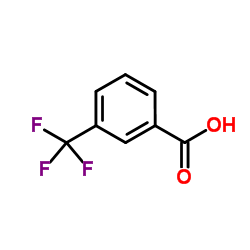Degradation of meta-trifluoromethylbenzoate by sequential microbial and photochemical treatments.
B F Taylor, J A Amador, H S Levinson
Index: FEMS Microbiol. Lett. 110(2) , 213-6, (1993)
Full Text: HTML
Abstract
m- and p-trifluoromethyl (TFM)-benzoates are incompletely degraded by aerobic bacteria that catabolize alkylbenzoates; biodegradation ceases after ring-fission with the accumulation of a trifluoromethyl muconate semialdehyde (2-hydroxy-6-oxo-7,7,7-trifluorohepta-2,4-dienoate, TFHOD) which is resistant to biochemical attack. A bacterium (Strain V-1), isolated from sea-water, grew aerobically on benzoate or m-toluate. Cells grown on benzoate or m-toluate oxidized both compounds at similar relative rates. Catabolism involved benzoate 1,2-dioxygenase (decarboxylating) and meta-cleavage to yield muconate semialdehydes. Cells grown on benzoate metabolized m-TFM-benzoate to TFHOD. The ring-fission products from m-toluate and TFHOD were degraded by sunlight, and equimolar fluoride was released from TFHOD. Sequential biochemical and photochemical treatment allowed the destruction of m-TFM-benzoate beyond the biochemically recalcitrant intermediate TFHOD.
Related Compounds
| Structure | Name/CAS No. | Molecular Formula | Articles |
|---|---|---|---|
 |
3-(Trifluoromethyl)benzoic acid
CAS:454-92-2 |
C8H5F3O2 |
|
The many roles for fluorine in medicinal chemistry.
2008-08-14 [J. Med. Chem. 51 , 4359-69, (2008)] |
|
Studies on the metabolism of fluorinated xenobiotics in the ...
1990-01-01 [J. Pharm. Biomed. Anal. 8(8-12) , 939-44, (1990)] |
|
Bacterial metabolism of side chain fluorinated aromatics: co...
1988-01-01 [Arch. Microbiol. 149(3) , 188-97, (1988)] |
|
Regioselective dioxygenation of ortho-trifluoromethylbenzoat...
1995-08-24 [Biochem. Biophys. Res. Commun. 213(3) , 759-67, (1995)] |
|
Polymeric drugs with prolonged sustained delivery of specifi...
2004-01-01 [J. Biomater. Sci. Polym. Ed. 15(7) , 917-28, (2004)] |